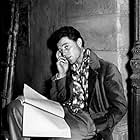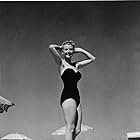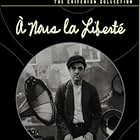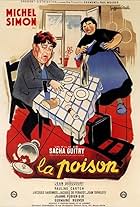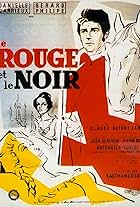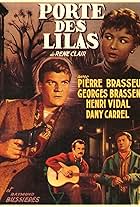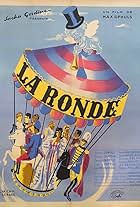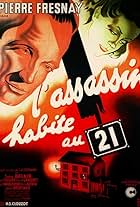IMDb RATING
7.3/10
1.9K
YOUR RATING
The Faust story retold, with an aged alchemist accepting the gift of renewed youth from the devilish Mephistopheles.The Faust story retold, with an aged alchemist accepting the gift of renewed youth from the devilish Mephistopheles.The Faust story retold, with an aged alchemist accepting the gift of renewed youth from the devilish Mephistopheles.
- Nominated for 1 BAFTA Award
- 4 wins & 1 nomination total
- Director
- Writers
- All cast & crew
- Production, box office & more at IMDbPro
Featured reviews
The Faust story has been adapted innumerable times. I have seen three adaptations: "Faust" (1926, Friedrich Wilhelm Murnau), "All that money can buy" (1941, William Dieterle) and this one of 1950 by Rene Clair.
It is interesting to see how different directors give a different interpretation to the story, maybe under influence of their national culture. The American production of Dieterle for example is by far the most materialistic interpretation, as the title already indicates. The European interpretations are more about non materialistic values as scientific curiosity and love (with the accent changing from the former to the latter when the wish of Faust for eternal youth has been granted by the Devil). Within the European interpretations the German one of Faust is much more pessimistic then the French one of Clair.
Not only the Faust character gives rise to different interpretations but also the Devil / Mephistopheles character. In "Le beaute du Diable" Michel Simon plays a sort of funny apprentice Devil, just like Henry Travers plays an apprentice angel in "It's a wonderful life" (1946, Frank Capra)
It is interesting to see how different directors give a different interpretation to the story, maybe under influence of their national culture. The American production of Dieterle for example is by far the most materialistic interpretation, as the title already indicates. The European interpretations are more about non materialistic values as scientific curiosity and love (with the accent changing from the former to the latter when the wish of Faust for eternal youth has been granted by the Devil). Within the European interpretations the German one of Faust is much more pessimistic then the French one of Clair.
Not only the Faust character gives rise to different interpretations but also the Devil / Mephistopheles character. In "Le beaute du Diable" Michel Simon plays a sort of funny apprentice Devil, just like Henry Travers plays an apprentice angel in "It's a wonderful life" (1946, Frank Capra)
René Clair located the action in an imaginary land ,at a time which is not historically precise: it may make you think of Italy and the characters of the prince and his wife might hint at a principality .A time which may remind you of the Renaissance or the seventeenth century when science and alchemy were not entirely differentiated :hence the people's wrath , sorcery was unholy ......Mephistopheles was one of the seven princes of Hell and one of the incarnations of the Devil;however, in the film,he's sent by the Devil (as Dominique and Gilles were envoys in "les visiteurs du soir" (1942),or on God' s side ,Clarence in "it's a wonderful life "(1945)). He's really on a mission .
Michel Simon ,actor extraordinaire ,as brilliant in the tragedy ("panique" ) as in the comedy ("drôle de drame" ) , was the best embodiment of the Devil I had ever seen;And Clair insisted his film be a tragi-comedy! Gérard Philipe 's portrayal was more contested ,but his boyish looks ,his romantic appeal and even his sniggering face when he appears for the first time cannot fail to win the audience over :his premature death was a major loss for the French cinema .Both actors play doubles ,which confuses the viewer and adds to the pleasure to watch these monstres sacrés together on the screen.
The first scene in the academy sets the tone :although doctor Faust is praised by his peers ,he's bored stiff during the ceremony (you should see Simon's face); a life devoted to science is an unfulfilled one ; by reading the lines in the palm of his hand,Marguerite (who appears as a gypsy ,an astute choice,for gypsies 'science is close to magic) tells him that "his life is over" .Naively ,Faust thinks that his true life,in which he will enjoy all the pleasures of life ,has begun.
Another side of the movie won't be lost on today's audience : after WW2, the fear of the atomic bomb reached peaks circa 1950; as Carné disguised the French resistance as a medieval fable in "les visiteurs du soir" ,Clair uses the legendary costume drama as a warning against the power of wealth and science : Faust becomes a pawn in the Devil's game he uses for destruction ,for man's downfall ; fortune and the princess are lures which can only be the death of the country and later on, the whole world .
Michel Simon ,actor extraordinaire ,as brilliant in the tragedy ("panique" ) as in the comedy ("drôle de drame" ) , was the best embodiment of the Devil I had ever seen;And Clair insisted his film be a tragi-comedy! Gérard Philipe 's portrayal was more contested ,but his boyish looks ,his romantic appeal and even his sniggering face when he appears for the first time cannot fail to win the audience over :his premature death was a major loss for the French cinema .Both actors play doubles ,which confuses the viewer and adds to the pleasure to watch these monstres sacrés together on the screen.
The first scene in the academy sets the tone :although doctor Faust is praised by his peers ,he's bored stiff during the ceremony (you should see Simon's face); a life devoted to science is an unfulfilled one ; by reading the lines in the palm of his hand,Marguerite (who appears as a gypsy ,an astute choice,for gypsies 'science is close to magic) tells him that "his life is over" .Naively ,Faust thinks that his true life,in which he will enjoy all the pleasures of life ,has begun.
Another side of the movie won't be lost on today's audience : after WW2, the fear of the atomic bomb reached peaks circa 1950; as Carné disguised the French resistance as a medieval fable in "les visiteurs du soir" ,Clair uses the legendary costume drama as a warning against the power of wealth and science : Faust becomes a pawn in the Devil's game he uses for destruction ,for man's downfall ; fortune and the princess are lures which can only be the death of the country and later on, the whole world .
Technically very well-made, with excellent performances by Michel Simon and Gérard Philippe- the rest of the cast is pretty forgettable. But somehow it sags in the middle and it all seems rather superficial and distant. You don't engage with the characters. The dialogue is too literary for modern tastes and the court scenes with their dances and music just fill up time. Smooth entertainment but it could have been much more gripping. I find Clair's next film, also with Gérard Philippe, funnier and better constructed.
Ah!my beauty past compare these jewels!
René Clair movies are ,in my humble opinion,among the least interesting of the old cinema:Duvivier,Carné ,Renoir,Pagnol,Clouzot and Grémillon are much more exciting.Even the so-called masterpieces such as "le million"(1931) or "quatorze juillet" fail to excite me.In America ,Clair made a valuable adaptation of Christie's "and then were none ,but I'm not sure he was the right director for that.Returning to France ,he released "le silence est d'or' which I personally find unpleasant ,and then "la beauté du diable".
"La beauté du diable" would be interesting,were it only for Michel Simon's sensational portrayal of Mephisto and handsome Gerard Philippe,although very good, is sometimes dwarfed by the old lion of the French cinema.The lines are sometimes witty and hints at the atomic bomb reflect the greatest fear of the era.Simone Valere,Jean Desailly's wife ,as the princess,finds here one of her rare good screen parts -she mainly worked on stage-
That said,Jacques Tourneur made a much better job with the devil in "la main du diable" ,which is the real granddaddy of "Rosemary's baby" or "Angel heart".
Gerard Philippe was to be featured in two Clair's subsequent works ,two overrated works ,"belles de nuit" and "les grandes manoeuvres" ,and alas,sans Michel Simon.
René Clair movies are ,in my humble opinion,among the least interesting of the old cinema:Duvivier,Carné ,Renoir,Pagnol,Clouzot and Grémillon are much more exciting.Even the so-called masterpieces such as "le million"(1931) or "quatorze juillet" fail to excite me.In America ,Clair made a valuable adaptation of Christie's "and then were none ,but I'm not sure he was the right director for that.Returning to France ,he released "le silence est d'or' which I personally find unpleasant ,and then "la beauté du diable".
"La beauté du diable" would be interesting,were it only for Michel Simon's sensational portrayal of Mephisto and handsome Gerard Philippe,although very good, is sometimes dwarfed by the old lion of the French cinema.The lines are sometimes witty and hints at the atomic bomb reflect the greatest fear of the era.Simone Valere,Jean Desailly's wife ,as the princess,finds here one of her rare good screen parts -she mainly worked on stage-
That said,Jacques Tourneur made a much better job with the devil in "la main du diable" ,which is the real granddaddy of "Rosemary's baby" or "Angel heart".
Gerard Philippe was to be featured in two Clair's subsequent works ,two overrated works ,"belles de nuit" and "les grandes manoeuvres" ,and alas,sans Michel Simon.
One of my sci-fi/horror/fantasy reviews written 50 years ago: Directed by Rene Clair; Produced by Salvo D'Angelo. A French-Italian co-production, released in America by Arthur Davis Associates. Screenplay by Rene Clair and Armand Salacrou; Photography by Michel Kelber; Camera by Gianni Di Venanzo; Edited by James Cuenet; Music by Roman Vlad; Assistant Director: Michel Boisrond. Starring: Michel Simon, Gerard Philipe, Simone Valere, Nicole Besnard, Carlo Ninchi, Raymond Cordy, Paolo Stoppa
Brilliant Clair revamping of the Faust myth, with Simon excelling as the Devil and Gerard the perfect romantic hero. Clair utilizes excellent special effects and ingeniously stylish gags in this ironic tale. Voluptuous Simone Valere not only delivers some white nightgown action, but also flashes some well-revealed supersize jugs.
Brilliant Clair revamping of the Faust myth, with Simon excelling as the Devil and Gerard the perfect romantic hero. Clair utilizes excellent special effects and ingeniously stylish gags in this ironic tale. Voluptuous Simone Valere not only delivers some white nightgown action, but also flashes some well-revealed supersize jugs.
Did you know
- Alternate versionsThere is an Italian DVD edition of the film, distributed by DNA Srl: "La Beauté du Diable". The film was re-edited with the contribution of the film history scholar Riccardo Cusin. This dvd contains the movie with its original aspect ratio and a new version adapted in 1.78:1 anamorphic for 16:9 screens. This version is also available in streaming on some platforms. This DVD also contains the movie "Faust" (1926) di F.W. Murnau.
- ConnectionsFeatured in Legendy mirovogo kino: Gérard Philipe
- How long is Beauty and the Devil?Powered by Alexa
Details
- Release date
- Countries of origin
- Language
- Also known as
- La beauté du diable
- Filming locations
- Production companies
- See more company credits at IMDbPro
- Runtime1 hour 36 minutes
- Color
- Aspect ratio
- 1.33 : 1
Contribute to this page
Suggest an edit or add missing content

Top Gap
By what name was The Beauty of the Devil (1950) officially released in India in English?
Answer










